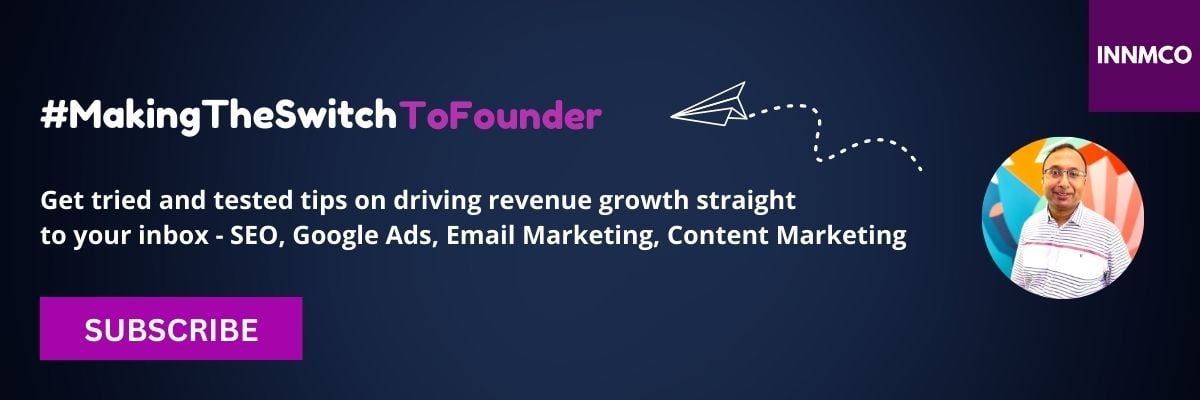Updated on: 26 July 2024
A brand is other people’s perception of what you do. No matter what the organisation says what they do, its all about how your target audience perceives you.
People around you will take time to be convinced of ‘what you say’ and ‘what you do’. They tend to look for social proof. A social proof in a business context includes:
-
Is this business good at what they are doing?
-
Is this business passionate about what they are doing?
-
Is this business talking about things (e.g. blog posts) that are aligned to what they are doing (e.g. services)?
In this article, I share my learnings while creating a brand awareness strategy for my business INNMCO. I also share examples of great customer experiences of products and services that I have personally used. In my view, these organisations have a strong brand and great brand building abilities.
I share key steps for creating a brand awareness strategy for your business.
1. Who is your customer?
It is important to identify your target audience, their needs challenges and behaviours. Having a clear understanding of your customers, their needs, challenges and behaviours will help you create a successful solution or offering that addresses their needs.
Research your customers. Learn more about their needs and challenges. Is there something that you can provide to address their needs an solve their challenges. These customer insights will help you create an offering that resonates with your target audience. This will also enable you to create marketing campaigns that speaks to this target audience.
As I was starting out on my entrepreneurship journey, I first spoke to a few prospective customers to learn more about their needs and challenges. I then tried to map this to services that I could potentially provide to address the needs and challenges of this prospective customer base.
Organisations typically serve a few customer segments. Each customer segment is defined by specific needs, challenges and behaviours. I want to walk you through a recent experience that I had while resolving an issue with my laptop. A few months back, my laptop screen ran into some issues. I was able to locate a link to a live chat with a service technician via google search. This led to a phone call and a service repair appointment booking at a retail outlet.
In the above example, the customer segment starts their journey to resolve issues online. They have unique needs, challenges and behaviours. Their path to issue resolution is slightly different in comparison to another customer segment, who prefers to walk into a retail outlet to explain their problem directly to the service technician.
This is a choice that an organisation makes regarding which customer segments they serve and the response mechanisms that need to be in place to address unique customer segment needs. All this adds to social proof and credibility building.
2. What’s your value proposition?
The next step in creating brand awareness is to start generating ideas to solve the unique needs, challenges and behaviours of your target audience. Rank the best idea. Your idea or innovation should address the unique needs, challenges and behaviours of the customer segment that wish to serve.
In my earlier example, a customer segment starts their journey to resolve issues online. The organisation was there at the right places to guide the customer through the journey to issue resolution.
The customer was able to find a solution via google search. This led to a live chat and a phone call with a service technician to discuss the issue further. This was followed by a service repair appointment at a retail outlet. ‘Customer Care’ is a core value for this organisation.
They definitely live by that value. The value proposition to their customer segment is their ability to resolve device issues via all channels of choice. This makes up for a great customer experience.
3. Where do your potential customers frequent the most?
Customer research shows which channels are most used by your target audience. It also provides insights on what type of content do they seek to address their needs and challenges.
As I was starting out on my entrepreneurship journey, I first spoke to a few prospective customers to learn more about what channels do they utilise to seek information to address their needs and challenges. This provided insights on what social media platforms they use and what publications they read.
This enabled me to create relevant content (e.g. blog posts, videos) and distribute them via their preferred channels.
4. What content types resonate with your potential customers?
Your customer research will also reveal what types of content best resonates with your target audience. This will guide your content strategy and the type of content (blogs, videos, webinars, etc.) you should create to be helpful. Knowing preferred content formats that resonate with your target audience will help generate more engagement from your posts.
In my earlier example, a customer segment starts their journey to resolve issues online. The live chat with a service technician definitely resonated with this customer segment. The customer segment was a looking for a way to contact someone for issue resolution and they were able to locate this person via google search.
5. What do you stand for?
Your core values guide your business and influence how you provide value to your customers. This will make your brand story distinct from that of your competitor.
If ‘customer care’ is one of your core values, how do you go about demonstrating ‘customer care’ to your target audience. Is it embedded in your company culture? Are there ways for your customer to reach you if they need some help with something? Actions speak louder than words.
Give helpful advice to your target audience to help them with problems they're facing related to your area of expertise. This will leave a positive impression about your brand with your target audience. This will keep your brand top of mind when they are looking for a solution to address their needs.
In my earlier example, the organisation demonstrated ‘customer care’ by being there at the right places in the issue resolution journey. They were available for issue resolution via live chat, phone call and online service repair appointments.
6. What is the right media mix to reach your target audience?
This also depends on your organisation’s go to market strategy. How do you sell your products? - self serve, inside sales or field sales.
Consider a mix of paid, owned and earned media while creating a digital marketing strategy. This will help you increase brand awareness, generate leads and win customers online.
One thing that I experienced while running paid media brand awareness campaigns for my business is that the product or service needs to solve a problem. You are not going to see results, if your product or service does not solve a problem that your target audience has.
Trial or test your product or service with your target audience to ensure that your offering solves a problem they actually have. Include friends and family, if they are part of your target audience. The positive reputation that your business or product or service gets, forms the basis for your brand strategy. This will increase brand recognition in the long term with your target audience.
7. Do you have marketing goals for your business or product or service?
Set SMART marketing goals that are aligned with your business goals. Allocate budget for marketing activities at different stages of the marketing funnel. An example of a SMART marketing goal for the awareness stage of the marketing funnel is:
‘Increase website traffic by 10% in the next 3 months, by doing '5' social media posts per week on LinkedIn.’
Allocating budget for marketing activities in the awareness stage of the marketing funnel, will ensure that your target audience is aware of your brand. This will help your target audience recognize your brand while they are in market for a solution to address their needs.
8. How do you build credibility with potential customers?
Launching a business? Get feedback by having people try your product or service. Show relevant case studies or reviews. This will help build confidence with your target audience and gain their trust in the long term.
Watch the video on how to build a brand awareness strategy?
An example of how a retailer innovated to addressed buyer needs and challenges. This helped them develop brand building abilities and create brand awareness.
During the pandemic, an electronics retailer was open for resolving technical issues with their products. They were able to change their model from in-store repairs to click-drop-collect for product repairs. The customers found out about the retailer’s technical support services via google search engine. The issue was first analysed via online chat, followed by phone technical support.
After recognising the problem, technical support booked an appointment to bring the item to the nearest service centre. A QR code was then emailed to the customer prior to check in at the store. Customers take their product to the nearest store and get contacted when it is repaired, usually within a couple of hours.
The electronics retailer quickly adapted their offering, from in-store repairs to click-drop-collect for product repairs. They were able to promote their brand voice and the new value proposition via search, online chat and phone consultation.
The electronics retailer was able to raise brand awareness and deliver customer value. They were able to create a unique value proposition that set them apart from competitors. This whole experience created a positive impression about the brand.
How to measure brand awareness?
Does your target audience recognise your brand? What is your brand identity or how does your target audience perceive your brand? Does your target audience know what products and services you offer?
A good way to measure this is to ask questions. Ask your target audience questions directly or through surveys. This will help you understand how they perceive your business, products or services? Do they know what your offer?
A second way to measure your brand awareness is through social listening. Some metrics to track include number of impressions, number of engagements, number of mentions of your brand on social media platforms.
A third way to measure your brand awareness is by analysing your search data. Look for branded search volumes.
A fourth way to measure your brand awareness is by analysing website traffic data. Look for metrics like number of unique visitors, number of back links to your website
These insights can be utilised to make improvements either to your messaging, content or offering.
Conclusion
The above eight steps will help in building awareness for your new or existing business. A brand is determined by your target audiences’ perceptions. It is a sum of all the experiences that your target audience has, while interacting with you across multiple channels. Measuring brand awareness through surveys, social listening, search and website traffic data will enable you to improve your brand awareness strategy.

Grow web traffic, leads & sales!
Founder & Digital Marketing Director, INNMCO
.png?width=200&height=125&name=Anees%20Misbahudeen%20-%20Company%20Profile%20(700%20%C3%97%20436%20px).png)
I help businesses grow web traffic, leads & sales. I am a digital marketing director specialising in SEO, Google Ads, email marketing & content marketing campaigns. I've supported the growth story of 30+ brands in software, financial services, automotive, manufacturing & B2B. I’ve 10+ years of digital marketing industry experience, as a founder, digital marketing strategist & consultant.

Share
.png?width=200&height=125&name=Anees%20Misbahudeen%20-%20Company%20Profile%20(700%20%C3%97%20436%20px).png)
.png?width=75&height=75&name=INNMCO%20Company%20Logo%20-%202025%20(700%20x%20700%20px).png)

.png)




